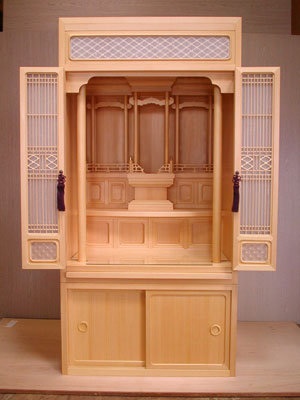Believe it or not, it begins (and to a degree, ends) with Singer sewing machine company. A collective wtf? Reverberates through the universe.
After the war, Singer contracted the Tsukada family to make sewing machine cabinets. The Tsukada family had manufactured butsudan, the altars in every Japanese home, for more than twenty generations:

I think it's very important to understanding the difference between Japanese and American attitudes for what happened next. Butsudan are by their nature the best woodworking on the planet, and every one is different. They reflect the status of the family that commissions them, as well as the maker:
http://tinyurl.com/pyrp8t6 (feast your eyes, gentlemen)
Imagine ten or more generations of your own family using the same family firm to craft altars for your home, and all of your relatives as well. Each customized to the smallest detail, while reflecting your family's particular style and status.
Fortunately the sewing machine market tanked, and the Singer/Tsukada company, Matsumoku began making guitars (mostly from wood left over from making butsudan) like Guyatone, Vox and Teisco Del Rey. With acoustics, they started with classical guitars and flattops, and quickly moved to archtops.
From Matsumoku's Wikipedia page:
https://en.m.wikipedia.org/wiki/Matsumoku quote:Matsumoku produced guitars, or parts of guitars, for Vox, Guyatone, FujiGen Gakki, Kanda Shokai (Greco), Hoshino Gakki (Ibanez), Nippon Gakki (Yamaha), Aria and Norlin (parent company of Gibson). American owned Unicord contracted Matsumoku to build most of its Univox and Westbury guitars. St. Louis Music Company imported Matsumoku built Electra Guitars. J. C. Penney sold Matsumoku built Skylark guitars through its catalog division. Matsumoku built many early Greco guitars as well as Memphis, Vantage, Westbury, Westminster, Cutler, Lyle and Fell. Washburn Guitars contracted Matsumoku to build most of its electric guitars from 1979 through 1987. Though the names above reflect Matsumoku's involvement, many of the names were later sold to other companies, which made completely different guitars in quality and sound.
In 1979, Matsumoku began to market its own guitars under the Westone name. ...
Confused yet? I know I am. From a guitar construction viewpoint, the earliest models had glaring deficiencies: the wood, glue and binding all reacted horribly to America's drier climate. The way Matsumoku addressed those issues were what led to the Alembic-inspired instruments we're discussing.
I'd like to return to the topic of the differences between Japanese and American guitar companies for a second, because it's only important to the point that both started moving their manufacturing operations to other Asian countries like the Philipines, Korea and Indonesia. Most of the instruments we're discussing were from the period that Japanese companies excelled at innovation and dependability (Toyotas and Datsuns from the 70s are still on the road. When's the last time you saw a Chevy Vega or Ford Granada?)
One of the VPs at Daddy's grew up in Japan and dealt with Japanese companies a lot. He said that everything was oriented towards teamwork. So each brand within a company was organized in independent autonomous groups (like the MacIntosh team within Apple), and each innovation or method was shared freely with all the other groups.
So if someone at Westone came up with (or stole ) an idea or method, by Friday Ibanez and Washburn would be doing it, too. (How well do you think Gibson, Fender and Martin would have shared info?)
Thus they arrived at neck-thru construction because they realized that the neck pocket acted as a hinge. (Or they just stole it from Alembic.) Matsumoku guitars began using three-piece laminated necks, with the grain of the middle lam at a 90 degree angle. They used better glues and binding material, brass hardware (as someone pointed out: sustain blocks).
In 1987, Singer went kaput, Matsumoku couldn't buy out their contract and the brands were broken up into independent units and sold off. By then most Japanese and American companies had established manufacturing in other Asian countries anyway, to add to the confusion.
Since we're discussing Alembic-ish guitars from a very brief era, from roughly 1980 to 1987, I think it's important to note what NOBODY has stolen from Alembic (with minor exceptions, of course): the two-piece adjustable brass nut. I worked as a repairman at Daddy's during its heyday as the world's largest retailer of used instruments, and even though I worked on thousands of instruments, I can count on one hand the number of times I saw a brass nut, period. I'm sure other repair dudes can verify.
Alembic electronics are unique, period. The pickup height adjustment. Never saw that anywhere else. Slotted tailpieces. Yeah, a few here and there, but never in a massive brass foundation. And my favorite; that beautiful masterpiece of form and function: the Alembic bridge (though that bridge on the 12-string pictured earlier looks familiar )
There were lots of other companies building guitars of varying quality, but for the purposes of this discussion, I believe Matsumoku was the primary exemplar of striving toward the same goals that Alembic achieved long ago and has sustained ever since: EXCELLENCE.
I don't think of them as copies or clones of Alembic. If so: not even close. They're more like nods in Alembic's direction. Tributes for lack of a better, more ironic word.
Too bad Alembic doesn't make altars, huh? Well, as far as I'm concerned, they do. But this isn't a religious discussion.